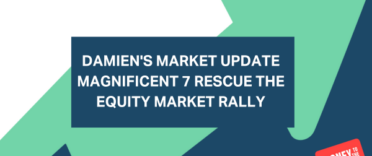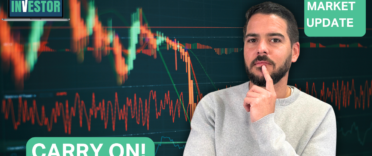Welcome to the latest episode of my monthly YouTube show where I discuss what is happening in investment markets and what to look out for. This episode I talk about the return of the perceived 'Goldilocks' scenario in the US, where everything supposedly appears 'just right'.
Each show lasts between 5-10 minutes and is aimed at DIY investors (including novices) seeking contemporary analysis to help them understand how investment markets work.
Subscribe to my YouTube channel to receive my weekly analysis of investment markets or alternatively, you can listen via my weekly Midweek Markets podcast below.
Damien's Market Update monthly podcast
Other ways to watch, listen and subscribe
You can listen to other episodes and subscribe to the show by searching 'Money to the Masses' on Spotify or by using the following links:
Abridged transcript - Damien's Market Update - September 2023
Despite a late-month surge, global stock markets concluded August in the red. Initially, the stock market decline at the start of August exhibited characteristics of healthy sector rotation into defensive stocks but, it eventually gave way to broader market weakness, with all sectors, including defensives, slipping into negative territory.
So what was behind this stock market weakness? Well, at the outset of August, the 10-year US treasury yield hovered just below 4%, but it surged to over 4.3% coinciding with the stock market's low point on August 21st. Consequently, the tech-heavy Nasdaq 100 experienced nearly a 7% dip at its August trough, as its positive correlation with the price of 10-year US treasuries re-emerged.
The primary catalyst behind the uptick in US treasury yields, the US dollar, and the stock market downturn was renewed concern that US interest rates might need to remain elevated for an extended duration. This apprehension stemmed from the release of strong economic data throughout August. In a similar vein, official UK data indicated that while inflation was receding, it stubbornly clung to elevated levels, prompting market expectations of additional rate hikes from the Bank of England (BOE).
As August drew to a close, attention turned to the Jackson Hole Symposium, where global central bankers convened, often sharing insights about inflation and future monetary policies. Recalling last year, the stock market unravelled following hawkish comments by Fed Chair Jerome Powell at the same event. This year, investors hoped to avoid a repeat performance. Somewhat regrettably for investors, Powell once again delivered a hawkish tone at this year's symposium, initially causing markets to price in at least one more interest rate hike by the Fed in the current year.
However, a slew of economic data during the final week of August hinted at the potential emergence of a new "Goldilocks" scenario in the US. This data suggested that despite elevated interest rates, the US consumer was faring well, and the US economy might steer clear of both a recession and overheating. This perceived Goldilocks scenario, where everything appeared "just right," where the Fed could potentially avoid further rate hikes (despite Powell's earlier hawkish stance) was in contrast to the market narrative earlier in August, and it fueled the late August rally in global equities.
So as we’ve moved into and through September, investors have clung to the Goldilocks narrative in the US.. This means that any new economic data releases have become crucial in supporting or quashing this narrative, while any central bank surprises have the potential to ignite volatility.
Early in September, US treasury yields rose again, and equity markets slumped as strong US services sector data raised concerns of overheating, spurring rate hike fears again. There was an element of deja-vu when comparing with the start of August. Higher oil prices, driven by supply cuts from Russia and Saudi Arabia, didn’t help by adding to inflation worries and increasing pressure on central banks. It led to the US dollar rallying towards its 2023 high.
But on a positive note for UK investors a weakening pound (after dovish the Bank of England Governor suggested the base rate was nearing its peak) versus the US dollar boosted overseas investments. Elsewhere, China's economic recovery showed some promise following interventions from Chinese authorities to prop up its economy, but a ban on iPhones for government workers led to a 6% drop in Apple's share price in a single day. As goes Apple so goes the market, which meant that the tech giant weighed on the S&P 500.
But one of the focal points of September was always going to be the monetary policy decisions from key central banks. Last week the European Central Bank (ECB) surprised the market with a 0.25% interest rate rise, causing the euro to drop. However, the ECB's statement suggested a peak in monetary tightening, leading to positive reactions in European equity and bond markets.
Attention now turns to the US Federal Reserve (Fed) and Bank of England decisions this week. BOE's Governor Andrew Bailey's recent remarks about falling inflation had already shifted market expectations for base rate hikes with the market now expecting just one more 0.25% increase. With the ECB and BOE appearing to be signaling a pause in rate hikes is on the cards. The question now is what the Fed will do? The market anticipates no action at its September policy meeting but is still leaving room for one more hike later in the year.
It all means so far September has followed the historical pattern of proving a challenge for investors but the market is starting to believe that major central banks are concluding their rate hiking cycles earlier than expected. If that is the case the transition could significantly impact asset performance, as we usher in a new phase of the interest rate cycle.
But for all the headlines and market narratives which chop and change, it can pay to keep things simple. So keep an eye on the strength of the US dollar and in turn bond yields. In particular, a rally in either has usually led to stock market weakness over recent months.



